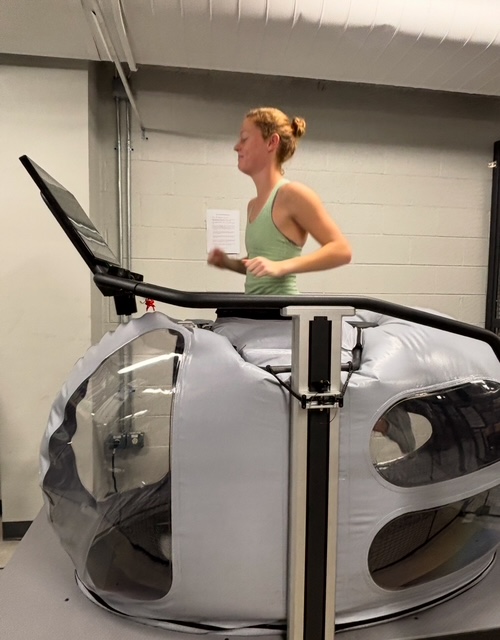In the fast-paced world of collegiate athletics, the pursuit of peak performance often requires innovative tools and strategies. For the women’s cross-country team at Washington and Lee University (WLU), the Boost Microgravity Treadmill has been an impactful tool on training and recovery. We sat down with Mike Dager, Head Coach of the Women’s Cross-Country Team, to discuss how the Boost has become an essential part of their program.
A Core Part of Weekly Training
The Boost has become a staple in the weekly training routine for the team, with 22-24 uses spread across both the men’s and women’s squads each week. Coach Dager emphasizes that it has been integrated in a way that accommodates both academic schedules and the demands of intense training.
“We have a core group of athletes who use the Boost every week, and we try to rotate in as many others as possible,” says Dager. “It’s been really helpful that athletes can use it during practice or even on extra run days, especially when their schedules allow for it.”
Managing Injuries & Enhancing Volume
An essential benefit of the Boost is its ability to help athletes manage injuries and increase training volume safely. For some athletes who may be injury prone or dealing with minor ailments, the Boost microgravity technology provides a way to continue running without exacerbating their issues.
“We’ve used the Boost to safely increase volume for injury-prone athletes,” explains Dager. “For example, one of our top women athletes had plantar fasciitis early in the season. After it calmed down, she was able to use the Boost every day for 3.5 weeks and didn’t miss a run. That’s a huge advantage—without it, she wouldn’t have been able to train at all.”
The results have been tangible: Dager notes that the team’s top women athletes are averaging 5-6 additional miles per week. “Over the course of the season, that’s going to add up and make a huge difference for us,” he says.
Training, Workouts, and Threshold Runs
The Boost at WLU is primarily used for training runs and, on occasion, for specific workouts. This is where the continuous threshold workout comes in, where athletes can push their limits in an effective and controlled manner, allowing them to run longer and slightly faster while reducing the impact on their bones and joints.
“On one workout day, we had an athlete do their threshold workout on the Boost instead of outdoors,” says Dager. “They were able to go faster and for longer, which is something they wouldn’t have been able to do otherwise.”

Integration into Training Plans
While microgravity technology is a valuable tool in the world of athletics, it’s not a “one-size-fits-all” approach. Dager and his coaching staff carefully consider when and how to integrate the Boost into an athlete’s training plan. For most healthy athletes, the Boost is used to supplement weekly mileage, with athletes typically running at 80-85% of their normal body weight.
However, for those returning from injury, the Boost allows for a gradual reintroduction to running. Dager mentions that some athletes returning from injury start with lower settings, such as 70% of body weight, to ease back into full body weight running.
Seamless Scheduling for Maximum Usage
To ensure every athlete gets the opportunity to use the Boost, scheduling is managed with precision. “We have an open Google Doc where athletes can sign up for available time slots,” explains Dager. “At the end of each week, we look at their schedules and plan accordingly. It’s all about making sure that we can accommodate as many athletes as possible while keeping the core group in their regular slots.”
The Boost’s Impact on Team Performance
When asked about the Microgravity Treadmill’s effect on team performance, Dager is enthusiastic. He credits the technology not only for its physical benefits but also for its mental impact.
“The unloading aspect is huge, especially after hard workouts,” says Dager. “It helps them feel fresher and recover faster. We’ve also had athletes doing long runs in the Boost, and it’s definitely been making a difference. I knew we were going to be good this season, but we’ve been performing even better than expected. Coming off a big result this past weekend, I think the Boost is having a tangible impact on our success.”
Moreover, Dager notes that the Boost has had a positive effect on team morale. “The athletes are really excited about having this tool in our program. They know we’ve invested in their success, and they’re motivated to use it to their advantage.”
Post-Season and Off-Season Use
Looking ahead, Dager plans to continue utilizing the Boost technology even after the championship season is over. While the team will take a short training break, the Boost will play a key role in helping athletes ease back into training after a little time off.
“Once the season wraps up, we’ll give the athletes a break and then gradually reintroduce them to training using the Boost,” says Dager. “It’s a great way to get them started again and help them adjust to higher volumes of training without the risk of injury.”
A Valuable Investment
In just a short amount of time, the Boost Treadmill has become an indispensable part of the WLU women’s cross-country program. From injury prevention to enhanced performance, microgravity technology has allowed athletes to train smarter and recover faster. With its continued integration into both regular and recovery runs, the Boost is giving WLU a competitive edge as they aim for success this season and beyond.
As Dager puts it, “The Boost is not just a physical benefit; it’s a mental boost too. Our athletes are motivated and confident knowing they have the tools to stay healthy and keep improving throughout the season.”
The future looks bright for the Generals, and with the Boost supporting their training, they’re well-positioned to keep pushing boundaries and achieving new milestones.
